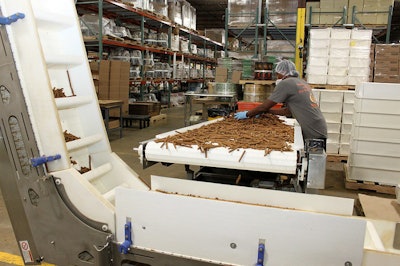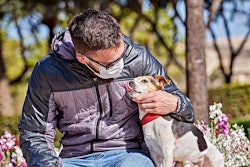
In the midst of the global coronavirus pandemic, pet food executives say their chief challenge is keeping their employees safe and healthy, according to the results to date of our Petfood Industry COVID-19 global survey. That was the top challenge selected by more than a third of survey respondents, 37%, with the second choice, product delivery or availability issues at retail, at 20%. Other choices included ingredient shortages/inconsistent supply (14%), cancelled orders/lost work due to uncertainty (11%) and labor shortages (3%). Completing the results was an “other” choice, with responses like “keeping sales force active as they self isolate.”
The survey, in the field since March 30, received responses from pet food professionals around the world, with the majority of respondents in North America (50%) and Europe (27%). Asia at 12%, Oceania at 6%, Latin America and Africa, each at 3%, were also represented. The respondents work predominantly in corporate or general management (41%) or sales and marketing (38%).
That most of these professionals are concerned about their staff’s safe and health is heartening and, at the same time, another sign of the human toll this crisis is inflicting. While maintaining a stable, experienced and well-trained workforce is key to business success, it’s also of high importance to pet food executives as people. After all, their companies often operate within a culture of support, teamwork and caring – forming a family of their own based on a common love for pets.
Pet food sales surges not likely to continue
In terms of business success, most of the respondents’ companies are enjoying it right now, with 52% reporting substantially increased sales (by double-digit percentages) of their pet food and treat since the COVID-19 crisis began; 26% said their sales have increased somewhat (by single-digit percentages). Some companies are experiencing sales declines at single- to double-digit rates (6% for each), while 11% said their sales have remained flat.
Most pet food market analysts and experts predict such sales surges are the result of pet owners stocking up to prevent running out of pet food in case of retail shortages, and thus are not sustainable. For example, Maria Lange, vice president of strategic verticals pet and cannabis for Nielsen, said their sales data indicate that most pet owners have two months’ supply of pet food on hand, so she expects a large decline in the second quarter of 2020.
Still, many pet food professionals are optimistic, according to our survey: 41% said they expect their company’s pet food and treat sales to continue to increase over the remainder of 2020, while 35% expect them to level off (leaving 24% expecting a decrease in their sales).
Tracking pet food availability and pricing globally
In the context of pet owners stocking up on pet food, perhaps even hoarding it, and the 20% of survey respondents saying their current top challenge related to the pandemic is product delivery or availability issues at retail, another data source on global outages of pet food provides some food for thought.
Euromonitor International’s Coronavirus Price and Availability Tracker allows you to see dog and cat food supplies by out-of-stock percentages at retail by country and by level of confirmed COVID-19 cases. You can also track available SKUs and median price over a period you select. (The tool also allows you to track pet dietary supplements, plus many other consumer goods unrelated to pet care.)
For example, the average out-of-stock percentage for dog food in the U.S. was about 8% through February and early March 2020, with the occasional rise up to about 9-10% or dip down to 4-6%. Then in late March, which is when Nielsen’s data showed significant surges in pet food sales in the U.S., Euromonitor’s showed out-of-stock percentages spiking up to about 12% on a couple of days.
The spikes were more noticeable in China, where the coronavirus outbreak originated in December 2019 and started accelerating in January. Out-of-stock percentages of dog food ranged between a low of about 5% to as high as 17% in February and most of March. Since late March and into April, as the country’s number of COVID-19 cases have reportedly continued to decline and the economy starts to open up, the out-of-stock percentages for dog food have averaged about 4%.
Similarly, Italy, which has been hit hard by the pandemic, had steadily rising dog food outage percentages starting in mid-February and peaking in March. South Korea, on the other hand, which initially seemed to be experiencing a severe outbreak of the coronavirus but quickly got it under control, has not seen any blips in its dog food supplies; the out-of-stock percentage from February to date has been consistently below 1%. Granted, that may very well be due to differences in its supply and distribution chain or retail sector irrespective of the COVID-19 crisis.
These are just snapshots in time with, admittedly, no statistical analysis applied. But the tracker provides a quick way to find clues as to whether the pandemic is affecting pet food stocks or pricing around the world.
Petfood Industry COVID-19 global survey
Find more information and participate in our survey here. And view our continuing coverage of the coronavirus/COVID-19 pandemic.


















